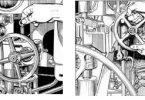INTERACTION IN NARROW CHANNELS
When vessels intend to pass in a narrow channel, whether on the same or opposing courses, it is important that the passing be carried out at a low speed.
The speed should be sufficient to maintain control adequately but below maximum for the depth of water so that in an emergency extra power is available to aid the rudder if necessary. If a reduction in speed is required it should be made in good time before the effects of interaction are felt. A low speed will lessen the increase in draught due to squat as well as the sinkage and change of trim caused by interaction itself.
Depending upon the dimensions of both the vessel and the channel, speed may have to be restricted. When vessels are approaching each other at this limiting speed interaction effects will be magnified, therefore a further reduction in speed may be necessary. Those in charge of the handling of small vessels should appreciate that more action may be required on their part when passing large vessels which may be severely limited in the action they can take in a narrow channel.
Regardless of the relative size of the vessels involved, an overtaking vessel should only commence an overtaking manoeuvre after the vessel to be overtaken has agreed to the manoeuvre


